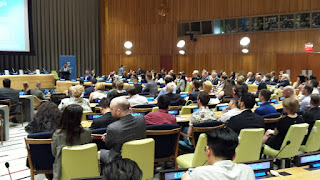Legal Analysis of Guyana cross-dressing analysis
Reposted January 9th, 2014
(By
Sheila I. Velez-Martinez)
A Commentary on McEwan, Fraser, Clarke, Persaud and SASOD vs. AG of Guyana
On
September 6, 2013, the High Court of the Supreme Court of Judicature of
Guyana released an important decision regarding the country’s law
prohibiting cross dressing “for an improper
purpose.” The decision and order in McEwan, Fraser, Clarke, Persaud and
SASOD vs. AG of Guyana includes both encouraging and troubling
elements.
In
the case, the High Court was called to address a constitutional
challenge to section 153(1)(xlvii) of the Summary Jurisdiction
(Offences) Act. Section 153(1)(xlvii) makes a criminal offence of a man
wearing female attire, and a woman wearing male attire, publicly, for
any improper purpose.
Chief
Justice Ian Chang decided that section 153 (1) (xlvii) is immune from
the constitutional challenge
brought by the four transgender litigants and their supporting
organizations. As an 1893 law, pre-dating Guyana’s independence, the
Chief Justice stated “legislative rather than curial action is necessary
to invalidate the provision.” In as much this provision was covered by
the “savings clause” of the Guyana Constitution.
I
join Inter American Human Rights Commissioner Rose-Marie Belle Antoine
in her criticism. The savings clauses inserted in the independent
constitutions across the Caribbean serve to perpetuate laws that were
not products of the independent nations’ own desires; not the result of
deep reflection about the nature and direction of the new Caribbean
societies.
In
a way the saving clause perpetuates legislation that is more foreign to
the current Caribbean that the conducts they proscribe, which as
Commissioner Bell Antoine has said “is quite ironic”.
The
High Court in this decision decisively engaged in a discoursive change
regarding the transgender community. Discourse elucidated by courts can
be as important as the decision inasmuch as it can have democracy
enhancing consequences as social movements move forward.
Chief
Justice Chang went to great lengths in the tone and style of his
opinion to distance the High Court from the conduct of the Chief
Magistrate who handled their cases after the initial detention.
According to the Decision, the Former Chief Magistrate Melissa Robertson
told them that they were “confused about their sexuality and they were
men and not women and that they must go to church and give their lives
to Jesus Christ.”
The
court referred to the plaintiffs consistently as “a transgendered
person” – who although possessing male primary sexual characteristics,
was identifying with the female gender. Because of his orientation, he
was not conforming to
masculine sex stereotypes such as the manner of dressing and comporting
himself.”
In
rendering the decision, the court recognised the existence of
transgender identities, declaring that the law “does not proscribe
trans-gender dressing per se.” The High Court went even further,
stating, “it is not criminally offensive for a person to wear the attire
of the opposite sex as a matter of preference or to give expression to
or to reflect his or her sexual orientation”.
As
the decision articulates the transgender right to self it also
demonstrates the inherent limitations of a formal equality framework
for facilitating meaningful critical engagement with concepts of sex and
gender. Although formal equality – treating trans-people the same as
non-trans-people despite gender non-conformity – may reduce instances of
blatant discrimination, it also serves to conceal and perpetuate the
underlying stigmatisation of non-conformity to gender norms.
This
is evident in the failure of the High Court to understand another
crucial point raised by the plaintiffs. That in its application Section
153 also discriminates against the transgender plaintiffs inasmuch as
because of their expression of their sexuality they are subject to
additional criminal penalties if engaged in conduct vaguely
labelled “improper”. The High Court reasoned that since the
“prohibition is against persons of both genders for doing the same kind
of acts; it cannot be successfully argued that the provision
discriminates on the basis of gender”.
It
is commendable that the High Court opens the door to the possibility of
challenging discriminatory acts based on gender under the
anti-discrimination provisions of article 149(2) of the Constitution.
Unfortunately, the analysis of the High Court conflates the concepts of
sex and gender. Gender is not merely the cultural manifestation of one’s
biological sex. In order for gender to be understood as a topic for
legal and political reform, it cannot be understood as flowing from
one’s inclusion in one of two
biologically determined sexes.
In
other words, sex denotes the biophysical aspects of personhood
associated with man and woman while gender denotes the social
constructions understood as “male and female” or “masculine and
feminine”. Gender tends to signify the personal appearance, personality
attributes, and socio-sexual roles that society considers to be
“masculine” or “feminine,” and which society imposes on individuals on
the basis of sex assignments. Gender non-conforming people challenge
this binary and expose the infinite possibilities of gender identities.
If
we aspire to a system of justice that operationalises the protection of
human rights and the principles of anti-subordination then, the formal
binary articulation of gender rights will be incompatible with the
complete protection of the rights of the gender nonconforming.
Protecting this community requires acknowledging the ontological
incompleteness of gender essentialism in representing the relational
dynamics in our societies.



Comments
Post a Comment